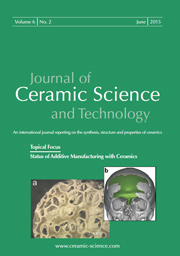Articles
All articles | Recent articles
On the Synthesis of Low-Cost, Titanium-Based MXenes
C. Li1, S. Kota2, C. Hu2, M.W. Barsoum2
1 Light Industry College of Liaoning University, Shenyang 110036, China
2 Department of Materials Science and Engineering, Drexel University, Philadelphia, Pennsylvania, USA 19104
received May 31, 2016, received in revised form July 17, 2016, accepted July 19, 2016
Vol. 7, No. 3, Pages 301-306 DOI: 10.4416/JCST2016-00042
Abstract
Herein we report methods to synthesize two MAX phases, Ti2AlC and Ti3AlC2, starting with rutile (TiO2), graphite and aluminum powders as raw materials. Adjusting the initial ratios of the raw materials led to the synthesis of multi-phase mixtures containing predominantly Ti2AlC-Al2O3 or Ti3AlC2-Al2O3. Free-standing Ti2CTx and Ti3C2Tx MXene films were successfully produced by etching the powders in a solution of hydrochloric acid with pre-dissolved lithium fluoride followed by sonication in water to produce colloidal suspensions of atomically thin MXene flakes. The Ti3C2Tx films produced from the lower-cost precursors retained the high electrical conductivity previously reported for this material. Since starting with rutile instead of Ti metal powders reduces the cost of the raw materials by a factor of about 2.6, this new, scalable approach to MXene synthesis is more economical.
![]() Download Full Article (PDF)
Download Full Article (PDF)
Keywords
MAX phase, MXene, ceramics, 2D materials, nanomaterials
References
1 Naguib, M. et al.: Two-dimensional nanocrystals produced by exfoliation of Ti3AlC2, Adv. Mater. 23, 4248 – 53, (2011).
2 Naguib, M. et al. Two-dimensional transition metal carbides, ACS Nano, 6, 1322 – 31, (2012).
3 Barsoum, M.W.: The MN+1AXN phases: A new class of solids; thermodynamically stable nanolaminates, Prog. Solid State Chem., 28, 201 – 281, (2000).
4 Ghidiu, M., Lukatskaya, M.R., Zhao, M.-Q., Gogotsi, Y., Barsoum, M.W.: Conductive two-dimensional titanium carbide "clay" with high volumetric capacitance, Nature, 4, 1716, (2014).
5 Hope, M.A. et al.: NMR reveals the surface functionalisation of Ti3C2 MXene, Phys. Chem. Chem. Phys., 18, 5099 – 5102, (2016).
6 Halim, J. et al.: X-ray photoelectron spectroscopy of select multi-layered transition metal carbides (MXenes), Appl. Surf. Sci., 362, 406 – 417, (2016).
7 Dillon, A.D. et al.: Highly conductive optical quality solution-processed films of 2D titanium carbide, Adv. Funct. Mater., 1 – 7, (2016).
8 Miranda, A., Halim, J., Barsoum, M.W., Lorke, A.: Electronic properties of freestanding Ti3C2Tx MXene monolayers, Appl. Phys. Lett., 108, 033102, (2016).
9 Lukatskaya, M.R. et al.: Cation intercalation and high volumetric capacitance of two-dimensional titanium carbide, Science, 341, 1502 – 5, (2013).
10 Dall, Y., Rozier, P., Taberna, P., Gogotsi, Y. Simon, P.: Capacitance of two-dimensional titanium carbide (MXene) and MXene/carbon nanotube composites in organic electrolytes, J. Power Sources, 306, 510 – 515, (2016).
11 Naguib, M. et al.: New two-dimensional niobium and vanadium carbides as promising materials for li-ion batteries, J. Am. Chem. Soc. 135, 15966 – 15969, (2013).
12 Wang, X. et al.: Pseudocapacitance of MXene nanosheets for high-power sodium-ion hybrid capacitors, Nat. Commun., 6, 6544, (2015).
13 Liang, X., Garsuch, A., Nazar, L.F.: Sulfur cathodes based on conductive MXene nanosheets for High- performance lithium – sulfur batteries, Angew. Chem. Int. Ed. Engl. 54, 1 – 6, (2015).
14 Dall'Agnese, Y., Taberna, P.-L., Gogotsi, Y., Simon, P.: Two-dimensional vanadium carbide (MXene) as positive electrode for sodium-ion capacitors, J. Phys. Chem. Lett. 2, 2305 – 2309, (2015).
15 Halim, J., Lukatskaya, M., Cook, K. et al.: Transparent conductive two-dimensional titanium carbide epitaxial thin films, Chem. Mater., 26, 2374 – 2381, (2014).
16 Hantanasirisakul, K. et al.: Fabrication of Ti3C2Tx MXene transparent thin films with tunable optoelectronic properties, Adv. Electron. Mater., (2016).
17 Peng, Q. et al.: Unique lead adsorption behavior of activated hydroxyl group in two-dimensional titanium carbide., J. Am. Chem. Soc., 136, 4113 – 4116, (2014).
18 Ying, Y. et al.: Two-dimensional titanium carbide for efficiently reductive removal of highly toxic Chromium(VI) from Water., ACS Appl. Mater. Interfaces, 7, 1795 – 1803, (2015).
19 Zhang, H. et al.: Preparation, mechanical and anti-friction performance of MXene/polymer composites, Mater. Des., 92, 682 – 689, (2016).
20 Chen, J., Li, J., Zhou, Y.: In-situ synthesis of Ti3AlC2/TiC-Al2O3 composite from TiO2-Al-C System., J. Mater. Sci. Technol., 22, 455 – 458, (2006).
21 Hendaoui, A., Vrel, D., Amara, A., Benaldjia, A., Langlois, P.: Ti-Al-C MAX phases by aluminothermic reduction process, Int. J. Self-Propagating High-Temperature Synth., 17, 125 – 128, (2008).
22 Cuskelly, D.T., Kisi, E.H., Sugo, H.O.: MAX phase – alumina composites via exchange reaction in the Mn+1AlCn systems (M=Ti, V, Cr, Nb, or Ta), J. Solid State Chem., 233, 150 – 157, (2016).
23 Yeh, C.L., Kuo, C.W., Chu, Y.C.: Formation of Ti3AlC2/Al2O3 and Ti2AlC/Al2O3 composites by combustion synthesis in Ti-Al-C-TiO2 systems., J. Alloy. Compd., 494, 132 – 136, (2010).
Copyright
Göller Verlag GmbH


